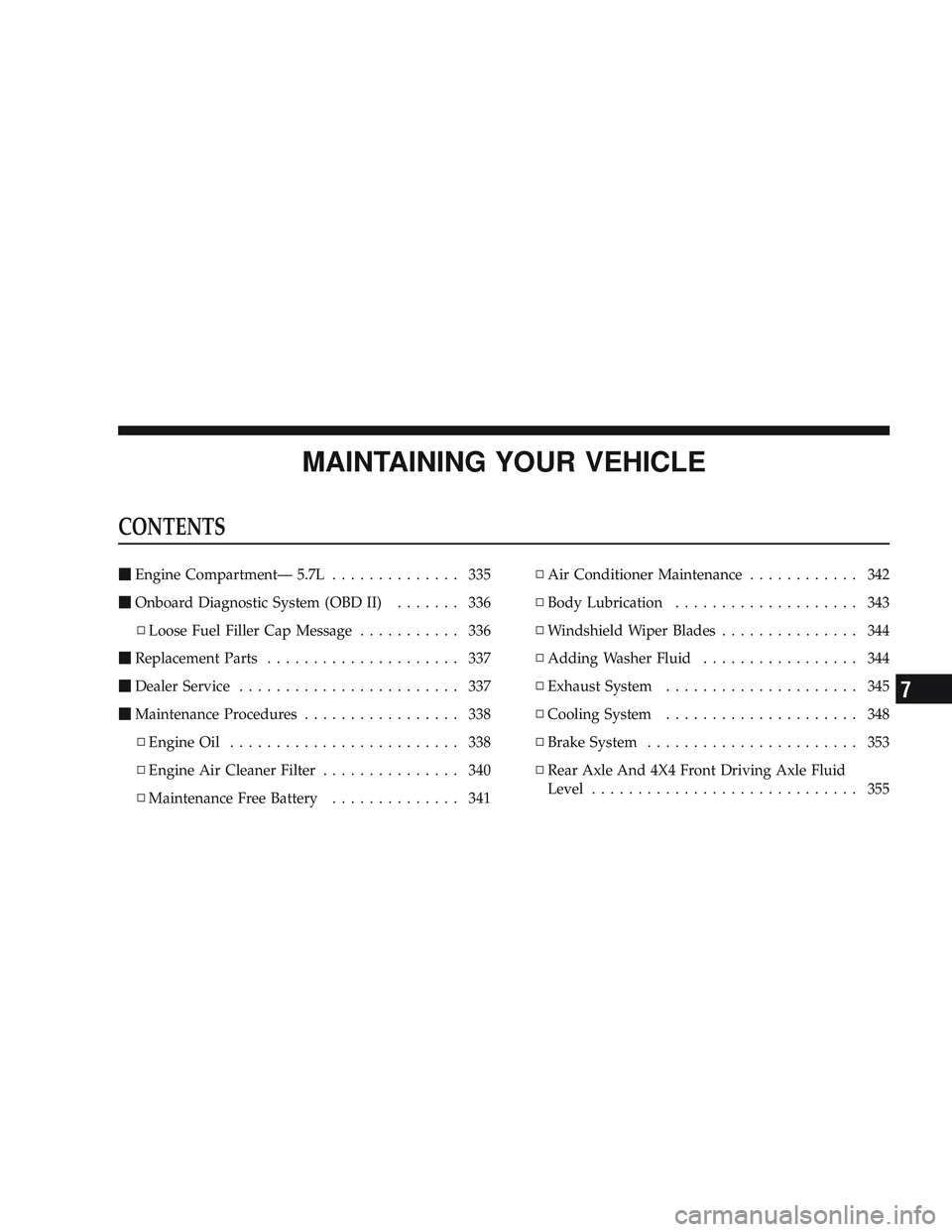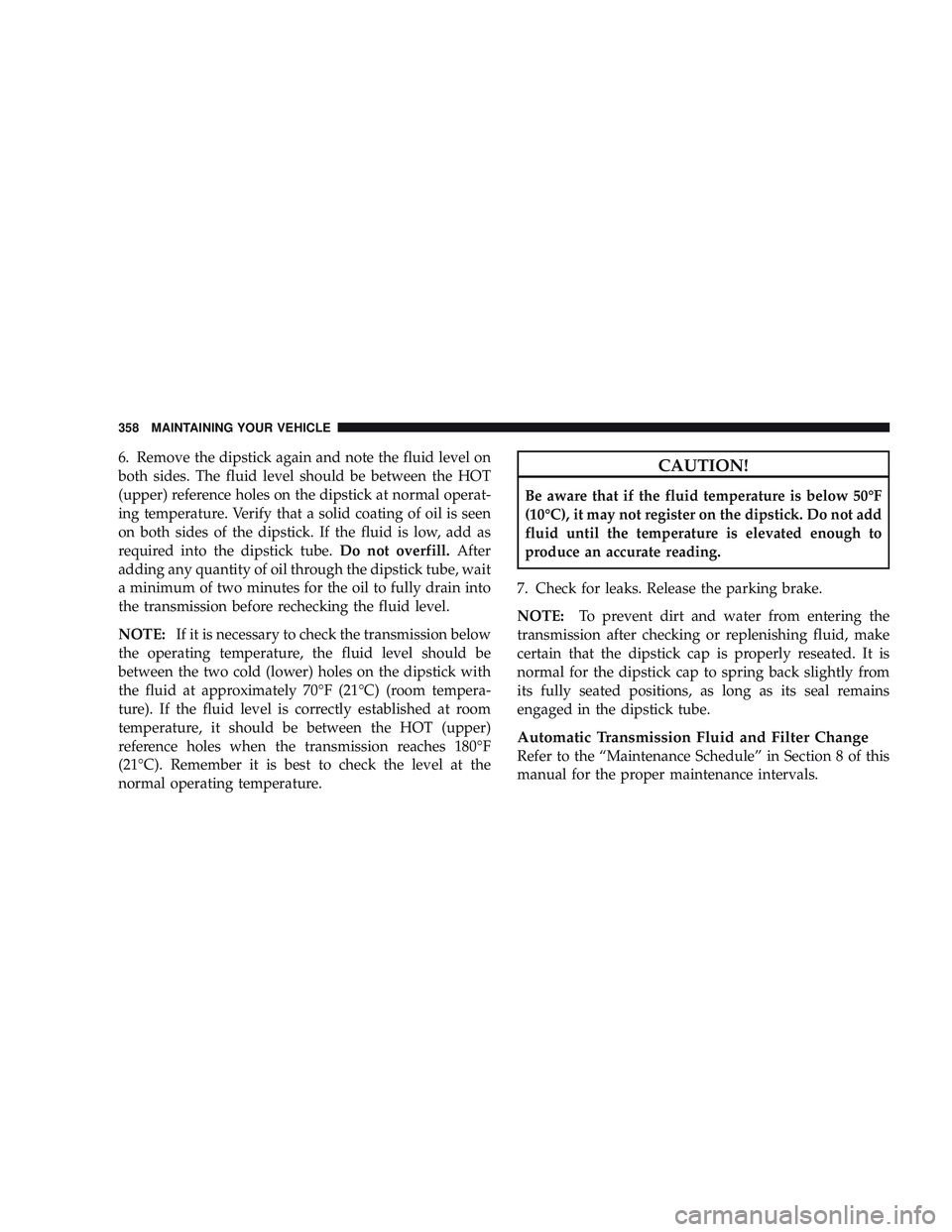adding oil RAM CHASSIS CAB 2009 Owners Manual
[x] Cancel search | Manufacturer: RAM, Model Year: 2009, Model line: CHASSIS CAB, Model: RAM CHASSIS CAB 2009Pages: 429, PDF Size: 3.51 MB
Page 335 of 429

MAINTAINING YOUR VEHICLE
CONTENTS
\2Engine Compartment— 5.7L .............. 335
\2 Onboard Diagnostic System (OBD II) ....... 336
\4 Loose Fuel Filler Cap Message ........... 336
\2 Replacement Parts ..................... 337
\2 Dealer Service ........................ 337
\2 Maintenance Procedures ................. 338
\4 Engine Oil ......................... 338
\4 Engine Air Cleaner Filter ............... 340
\4 Maintenance Free Battery .............. 341 \4
Air Conditioner Maintenance ............ 342
\4 Body Lubrication .................... 343
\4 Windshield Wiper Blades ............... 344
\4 Adding Washer Fluid ................. 344
\4 Exhaust System ..................... 345
\4 Cooling System ..................... 348
\4 Brake System ....................... 353
\4 Rear Axle And 4X4 Front Driving Axle Fluid
Level ............................. 355
7
Page 340 of 429

MAINTENANCE PROCEDURES
The pages that follow contain therequiredmaintenance
services determined by the engineers who designed your
vehicle.
Besides the maintenance items for which there are fixed
maintenance intervals, there are other items that should
operate satisfactorily without periodic maintenance.
However, if a malfunction of these items does occur, it
could adversely affect the engine or vehicle performance.
These items should be inspected if a malfunction is
observed or suspected.
Engine Oil
Checking Oil Level
To assure proper lubrication of your vehicle’s engine, the
engine oil must be maintained at the correct level. Check
the oil level at regular intervals. The best time to check
the oil level is before starting the engine after it has been
parked overnight. When checking oil after operating the engine, first ensure the engine is at full operating tem-
perature, then wait for 15 minutes after engine shutdown
to check the oil.
Checking the oil while the vehicle is on level ground will
improve the accuracy of the oil level readings. Always
maintain the oil level within the SAFE zone on the
dipstick. Adding one quart of oil when the reading is at
the bottom of the SAFE zone will result in a reading at the
top of the safe zone on these engines.
CAUTION!
Overfilling or underfilling the crankcase will cause
oil aeration or loss of oil pressure. This could damage
your engine.
Never operate the engine with oil level below the “ADD”
mark or above the upper “SAFE” mark.
338 MAINTAINING YOUR VEHICLE
Page 345 of 429

WARNING! (Continued)
•The air conditioning system contains refrigerant
under high pressure. To avoid risk of personal
injury or damage to the system, adding refrigerant
or any repair requiring lines to be disconnected
should be done by an experienced repair person.
NOTE: Use only manufacturer approved A/C System
Sealers, Stop Leak Products, Seal Conditioners, Compres-
sor Oil, or Refrigerants.
Refrigerant Recovery and Recycling
R-134a air conditioning refrigerant is a hydrofluoro-
carbon (HFC) that is endorsed by the Environmental
Protection Agency and is an ozone-saving product. How-
ever, the manufacturer recommends that air conditioning
service be performed by authorized dealers or other
service facilities using recovery and recycling equipment.
Body Lubrication
Locks and all body pivot points, including such items as
seat tracks, door hinge pivot points and rollers, liftgate,
tailgate, sliding doors and hood hinges, should be lubri-
cated periodically with a lithium based grease such as
MOPAR\3 Spray White Lube to assure quiet, easy opera-
tion and to protect against rust and wear. Prior to the
application of any lubricant, the parts concerned should
be wiped clean to remove dust and grit; after lubricating
excess oil and grease should be removed. Particular
attention should also be given to hood latching compo-
nents to insure proper function. When performing other
underhood services, the hood latch, release mechanism
and safety catch should be cleaned and lubricated.
The external lock cylinders should be lubricated twice a
year, preferably in the Fall and Spring. Apply a small
amount of a high quality lubricant such as MOPAR\3
Lock Cylinder Lubricant directly into the lock cylinder.
MAINTAINING YOUR VEHICLE 343
7
Page 346 of 429

Windshield Wiper Blades
Clean the rubber edges of the wiper blades and the
windshield periodically with a sponge or soft cloth and a
mild nonabrasive cleaner. This will remove accumula-
tions of salt or road film.
Operation of the wipers on dry glass for long periods
may cause deterioration of the wiper blades. Always use
washer fluid when using the wipers to remove salt or dirt
from a dry windshield.
Avoid using the wiper blades to remove frost or ice from
the windshield. Keep the blade rubber out of contact with
petroleum products such as engine oil, gasoline, etc.
Adding Washer Fluid
The fluid reservoir is located under the hood and should
be checked for fluid level at regular intervals. Fill the
reservoir with windshield washer solvent only (not ra-
diator antifreeze). When refilling the washer fluid reser-
voir, take some washer fluid and apply it to a cloth or
towel and wipe clean the wiper blades; this will help
blade performance.
To prevent freeze-up of your windshield washer system
in cold weather, select a solution or mixture that meets or
exceeds the temperature range of your climate. This
rating information can be found on most washer fluid
containers.
The washer fluid reservoir will hold a full gallon/liter of
fluid when the “Low Washer Fluid Light” illuminates.
344 MAINTAINING YOUR VEHICLE
Page 360 of 429

6. Remove the dipstick again and note the fluid level on
both sides. The fluid level should be between the HOT
(upper) reference holes on the dipstick at normal operat-
ing temperature. Verify that a solid coating of oil is seen
on both sides of the dipstick. If the fluid is low, add as
required into the dipstick tube.Do not overfill.After
adding any quantity of oil through the dipstick tube, wait
a minimum of two minutes for the oil to fully drain into
the transmission before rechecking the fluid level.
NOTE: If it is necessary to check the transmission below
the operating temperature, the fluid level should be
between the two cold (lower) holes on the dipstick with
the fluid at approximately 70°F (21°C) (room tempera-
ture). If the fluid level is correctly established at room
temperature, it should be between the HOT (upper)
reference holes when the transmission reaches 180°F
(21°C). Remember it is best to check the level at the
normal operating temperature.CAUTION!
Be aware that if the fluid temperature is below 50°F
(10°C), it may not register on the dipstick. Do not add
fluid until the temperature is elevated enough to
produce an accurate reading.
7. Check for leaks. Release the parking brake.
NOTE: To prevent dirt and water from entering the
transmission after checking or replenishing fluid, make
certain that the dipstick cap is properly reseated. It is
normal for the dipstick cap to spring back slightly from
its fully seated positions, as long as its seal remains
engaged in the dipstick tube.
Automatic Transmission Fluid and Filter Change
Refer to the “Maintenance Schedule” in Section 8 of this
manual for the proper maintenance intervals.
358 MAINTAINING YOUR VEHICLE
Page 414 of 429

CleaningWheels ............................. 361
Climate Control ......................... 204
Clock ........................ 172,175,189,195
Compact Disc (CD) Maintenance ............. 203
Compass ........................... 140,141
Compass Calibration ..................... 141
Compass Variance ....................... 143
Computer, Trip/Travel .................... 136
Contract, Service ........................ 403
Coolant Pressure Cap (Radiator Cap) .......... 351
Cooling System ......................... 348
Adding Coolant (Antifreeze) .............. 350
Coolant Capacity ...................... 377
Coolant Level ...................... 348,352
Disposal of Used Coolant ................ 352
Drain, Flush, and Refill .................. 349
Inspection ........................... 352
Points to Remember .................... 352 Pressure Cap
......................... 351
Radiator Cap ......................... 351
Selection of Coolant (Antifreeze) .........349,378
Cruise Control (Speed Control) .............. 133
Cupholders ............................ 146
Customer Assistance ..................... 401
Data Recorder, Event ...................... 57
Daytime Running Lights ................... 126
Dealer Service .......................... 337
Defroster, Rear Window ................... 153
Defroster, Windshield ................74,205,208
Delay (Intermittent) Wipers ................. 129
Differential, Limited-Slip .................. 249
Dipsticks .............................. 338
Power Steering ........................ 253
Disposal .............................. 340
Antifreeze (Engine Coolant) ............... 352
Engine Oil ........................... 340
412 INDEX
Page 416 of 429

Fabric Care............................ 361
Filters Air Cleaner .......................... 340
Engine Fuel .......................... 378
Engine Oil ..................... 338,340,378
Flashers Turn Signal .......................... 127
Flat Tire Stowage ........................ 326
Flooded Engine Starting ................... 222
Fluid, Brake ........................... 379
Fluid Capacities ......................... 377
Fluid Level Checks Brake .............................. 353
Manual Transmission ................... 356
Power Steering ........................ 253
Transfer Case ......................... 356
Fluids, Lubricants and Genuine Parts .......... 378
Fog Lights ....................... 126,167,374
Fold Flat Load Floor ..................... 154 Four Wheel Drive
....................... 230
Four-Way Hazard Flasher .................. 314
Freeing A Stuck Vehicle ................... 330
Front Axle (Differential) ................... 355
Fuel ................................. 281
Adding ............................. 285
Diesel .............................. 378
Filler Cap (Gas Cap) .................... 286
Filter ............................... 378
Gauge .............................. 171
Light ............................... 172
Octane Rating ........................ 281
Requirements ......................... 281
Tank Capacity ........................ 377
Fuses ................................ 364
Gas Cap (Fuel Filler Cap) ...............286,336
Gasoline (Fuel) ......................... 281
Gasoline, Reformulated ................... 281
414 INDEX